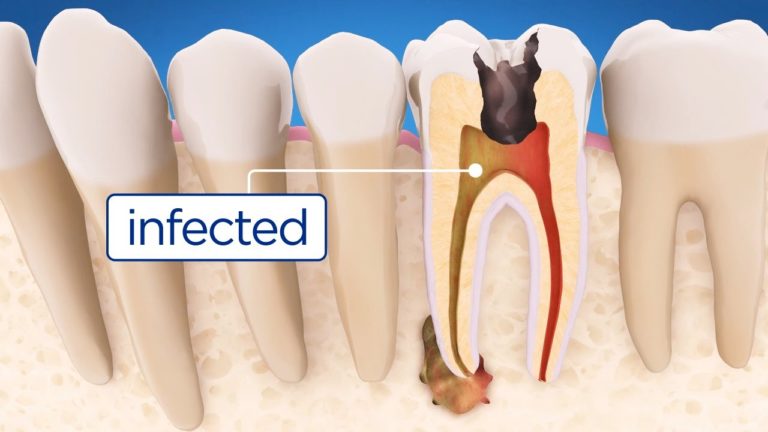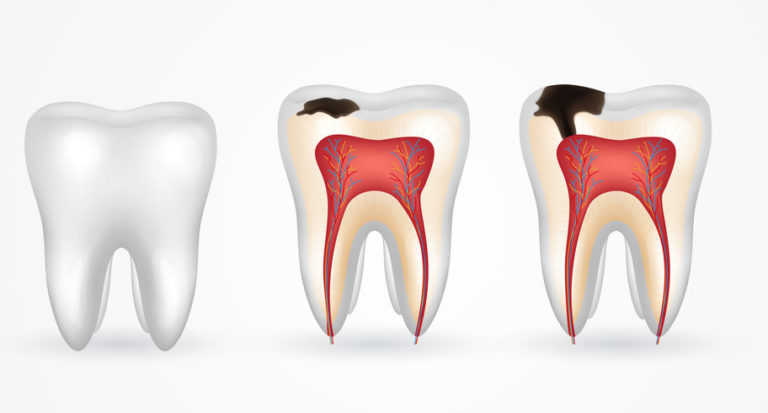Root Canal Treatment
DECAY: Levels of infection
Dental caries commonly known as dental decay commonly begins with the involvement of the outermost layer of teeth known as the Enamel. As the decay progresses, it goes on to involve Dentin and then the innermost layer PULP. While the decay is restricted in the Enamel and Dentin layer, conservative treatment such as Composite filling can be carried out successfully.
When is Root Canal Treatment Carried out?
Once the decay crosses the barrier of Dentin and involves the vital innermost tissue of the tooth i.e., PULP, the tooth then need a more invasive or extensive treatment such as an Indirect Pulp Capping or Root Canal Treatment. It is a multistep process in which the infected Pulp from the tooth is removed and is replaced by a more biocompatible or biomimetic material.


In the picture above, the infection has not only reached the pulp but also spread around the tooth root in bone area. In such cases, the tooth is treated only with Root Canal Treatment or Extraction.
Steps of Root Canal Treatment

The treatment of primary and young permanent teeth is quite safe and predictable, backed by a wide research detailing the best clinical techniques and practices. With sound clinical techniques and some rather extraordinary compounds, a lot can be done to save baby teeth.
The treatment involves complete removal of all the pulp tissue because it is infected and replacing it with a healthy tooth structure.
A small opening is drilled in the biting surface of the tooth to drain infection. A course of antibiotics is prescribed simultaneously. This will set the stage for the removal of infected tissue from the root canal/s completely. This traditional procedure of root canal treatment involves:
- Drilling the occluding surface of the tooth
- The removal of all the infected tissue from the root canals
- Disinfecting
- Cleaning and shaping and filling the canals to seal them.
- The material used to replace the lost tissue is biocompatible and in some cases Bio-mimetic. Such a material is resorbable so that the body can absorb the roots normally, allowing the primary tooth to be lost and replaced by its permanent successor.
Why to protect and preserve Milk Teeth?
The first set of teeth in the mouth serve a number of very important functions. The health and well-being of these primary teeth also affects the development of the permanent teet
The primary teeth are often looked at as “disposable” because they are going to fall out early on in life. Parents and caregivers can be under the impression that, since milk teeth are not permanent, they are not important. That cannot be further from the truth. There are some very important roles that primary teeth play in the mouth. Let’s have a look at some of them in detail.
Primary teeth help the child chew
The eating habits that a child develops dictate a lot of how the child’s overall growth and development will take place. A child who has decayed, painful, or missing primary teeth is going to be unable to chew food properly. In fact, a really young child may also not be able to verbalize the fact that there is something wrong with the teeth.
Primary teeth participate in speech development
The presence of a complete set of healthy teeth in the child’s mouth is very helpful for normal speech development. There are several studies which have shown that the absence of primary teeth can increase the chances of developing a speech disorder. This is just one more reason to take caring for primary teeth seriously.
Primary teeth are guides for the permanent teeth
One of the most important functions of the primary teeth in the mouth is to help guide the permanent teeth into their right place. The permanent teeth start to develop near the roots of the primary teeth. As the age of the child progresses, these permanent teeth start to follow the roots of the primary teeth and then erupt in the right place.
Primary teeth maintain space in the jaw for the permanent teeth
The primary teeth are much smaller than the permanent teeth. However, the design of their roots is flared and so they can help the larger permanent tooth come into the right place. One more essential functions of the primary teeth is to keep adequate space for the erupting permanent teeth.
Crowns?? Are they essential after Root Canal Treatment?
“The main purpose of a crown is to restore strength, functionality, shape and size to a tooth, and to improve its appearance.”
The capacity of of any structure to protect or prevent its breaking or FRACTURE depends on a physical property called RESILIENCE. The resilience of a tooth is provided by its DENTIN layer, the layer just below the ENAMEL. A root canal treatment is performed in a tooth that was badly infected and may have lost a lot of its tooth structures, most importantly its DENTIN. Thus, a tooth that needs Root Canal Treatment lacks RESILIENCE and is more prone to fracture than a healthy tooth. Thus, such a tooth is usually restored with placement of a crown post a Root Canal Treatment.

